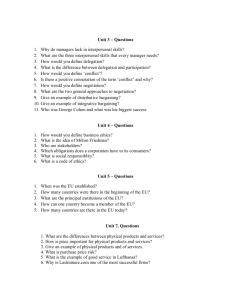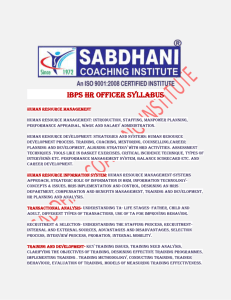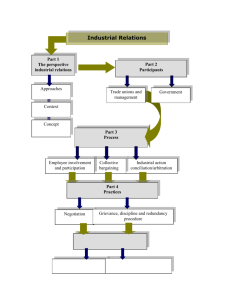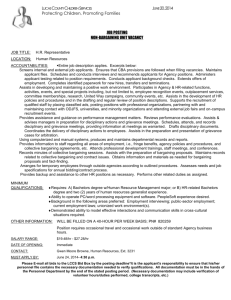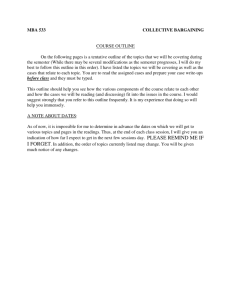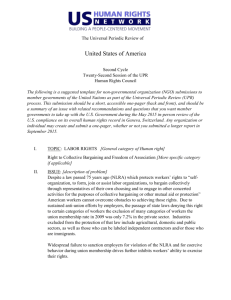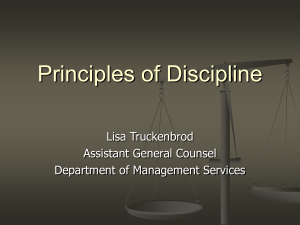HRM for MBA Students
advertisement
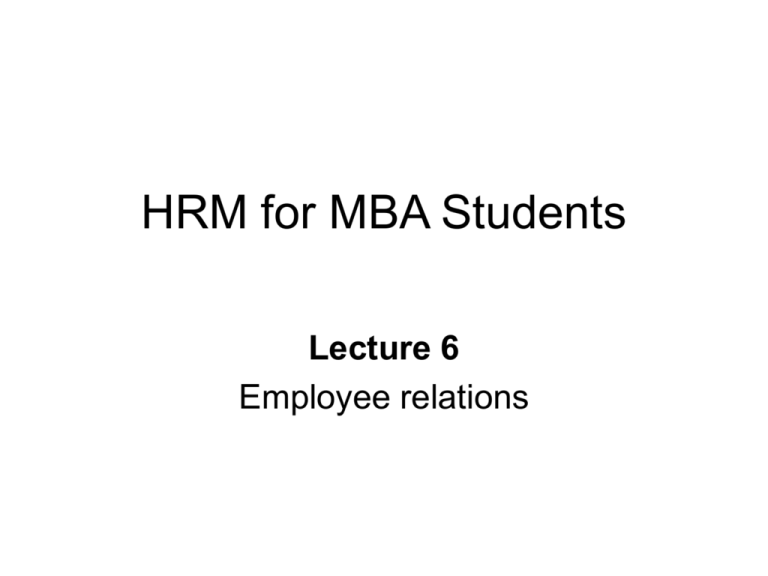
HRM for MBA Students Lecture 6 Employee relations Learning outcomes • Understanding and evaluating the main explanations given for conflict in organisations • Understanding the nature of negotiations in the context of employee relations • Understanding the purpose and nature of both grievance and disciplinary procedures • Familiarity with the process of traditional collective bargaining and agreements • Familiarity with the main forms of industrial action • Understanding the nature of ‘new employee relations’ • Understanding the concepts of employee engagement and employee voice Employee relations • The policies and practices an organisation uses in dealing with its employees • Also, the systems of rules and mechanisms by which organisations and employees interact with each other The term covers both collective relations and policies and procedures which operate at small-group or individual level – eg disciplinary or grievance procedures Grievance and discipline • Most managers would agree that it is inevitable that there are issues concerning grievances and discipline in most, if not all, organisations • Employers (managers) and employees (workforce) both have legal rights and responsibilities • They also both have informal expectations of each other Employees’ expectations • That employers will treat them reasonably, fairly and consistently • That action will only be taken against them on the basis of just cause and after proper and thorough investigation Employees will feel they have a right to pursue a grievance if these expectations are not met Employers’ expectations • That employees will perform their duties and tasks in a satisfactory manner in accordance with their legal obligations and the organisational policies and procedures • That, if the employees’ performance is not satisfactory, employers have the right to take appropriate action – which could include disciplinary action The employment relations process • The employment relationship is usually seen by both sides as an ongoing relationship which should survive the resolution of any particular dispute, whether individual or collective • If grievance and disciplinary cases are dealt with properly, we assume that employee dissatisfaction should be reduced and motivation increased, with consequent improvements in individual, team and organisational performance The employment relations process (cont.) • Good grievance and disciplinary procedures typically are set in stages, and on the basis that issues should be dealt with as close to their origin as possible • The general principle is always to deal with issues at the lowest level possible given the nature of the inappropriate behaviour Negotiation • is defined as: a process for resolving conflict between two parties whereby both modify their demands to achieve a mutually acceptable compromise. Kennedy et al (1984, p.12) Conditions needed for collective bargaining • Both management and the workforce must be organised: this implies the existence of trade unions or some other sort of association representing the employees • Formal recognition of the trade unions or other employee association(s) by management • Mutual agreement to negotiate in good faith and to keep the agreements that are reached Characteristics of the negotiating process in employee relations • • • • • The parties are not involved in a one-off negotiation and usually want to continue working together after the negotiation or bargaining has been completed The negotiation is usually about more than one issue – eg basic pay and some aspect of working conditions or some other benefits Negotiations are conducted by representatives from each side and so agreements reached by them will require endorsement from the wider parties Each side must establish its priorities, strategies and tactics before the negotiations start Once an agreement has been reached, there is joint responsibility to make it work Negotiation MANAGEMENT’S BARGAINING RANGE Ideal settlement point Target point Resistance point Bargaining parameters Resistance point Target point EMPLOYEES’ BARGAINING RANGE (via trade union or staff association) Ideal settlement point Some types of collective agreements • Single-union recognition • Partnership agreements • New-style agreements Dispute resolution: arbitration, conciliation and mediation • Arbitration – a third party, the arbitrator, reviews and discusses the negotiating stances of the disagreeing parties and makes a recommendation on the terms of settlement which is binding on both parties • Conciliation – a third party (eg ACAS) attempts to get the two parties to agree on terms. Conciliators do not make recommendations • Mediation – a third party makes recommendations which the parties are not bound to accept Informal employee relations processes • Managers should always remember that within that formal framework of negotiation, bargaining, etc , informal employee relations processes are taking place continuously, whenever a line manager or team leader is handling an issue in contact with an employee representative, an individual employee or a group of employees Industrial action • The sanctions which employees may resort to if bargaining or negotiation does not produce an acceptable result • Informal industrial action is represented mostly by individual, unorganised forms of action such as: – – – – – – – – high labour turnover poor time-keeping high absenteeism withholding of effort inefficient working time-wasting sabotage complaints Formal industrial action • • • • • • Working to rule Go-slow Overtime ban Strike (withdrawal of labour) Sit-in (occupation of workplace) Work-in (occupation of workplace and attempt to keep it operating without management) The ‘new employee relations’ In general [the employee relations agenda] is no longer about trade unions. There is more emphasis on direct communication, managing organisational change and involving and motivating staff. Issues about work–life balance and the war for talent reflect a changing workforce with changing expectations. The CIPD (2005) The ‘new employee relations’ (cont.) ... but employee relations skills and competencies are still critical to achieving performance benefits. The focus now needs to be on gaining and retaining employee commitment and engagement. The CIPD (2005) Employee engagement • [Employee engagement] ‘can be seen as a combination of commitment to the organisation and its values plus a willingness to help out colleagues (organisational citizenship). It goes beyond job satisfaction and is not simply motivation. Engagement is something the employee has to offer: it cannot be “required” as part of the employment contract.’ • ‘Employers want engaged employees because they deliver improved business performance’ The CIPD (2007) Drivers of engagement • Involvement in decision-making – having opportunities to feed views ‘upwards’ • Freedom to voice ideas, to which managers listen • Feeling enabled to perform well • Having opportunities to develop the job • Feeling that the organisation is concerned for employees’ health and well-being Institute of Employment Studies Employee voice • ‘Upward problem-solving’ and ‘representative participation’ to increase the exchange of information between managers and employees • Replacing or supplementing traditional, indirect means of communication such as joint consultation • Seeking to promote engagement and higher performance at work
![Labor Management Relations [Opens in New Window]](http://s3.studylib.net/store/data/006750373_1-d299a6861c58d67d0e98709a44e4f857-300x300.png)
